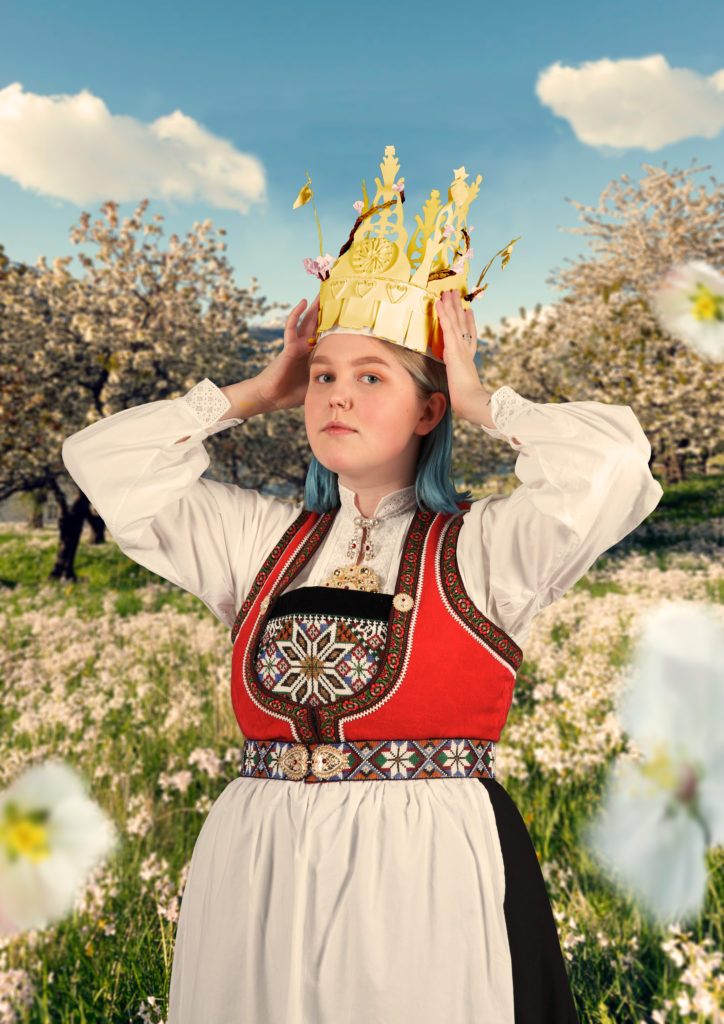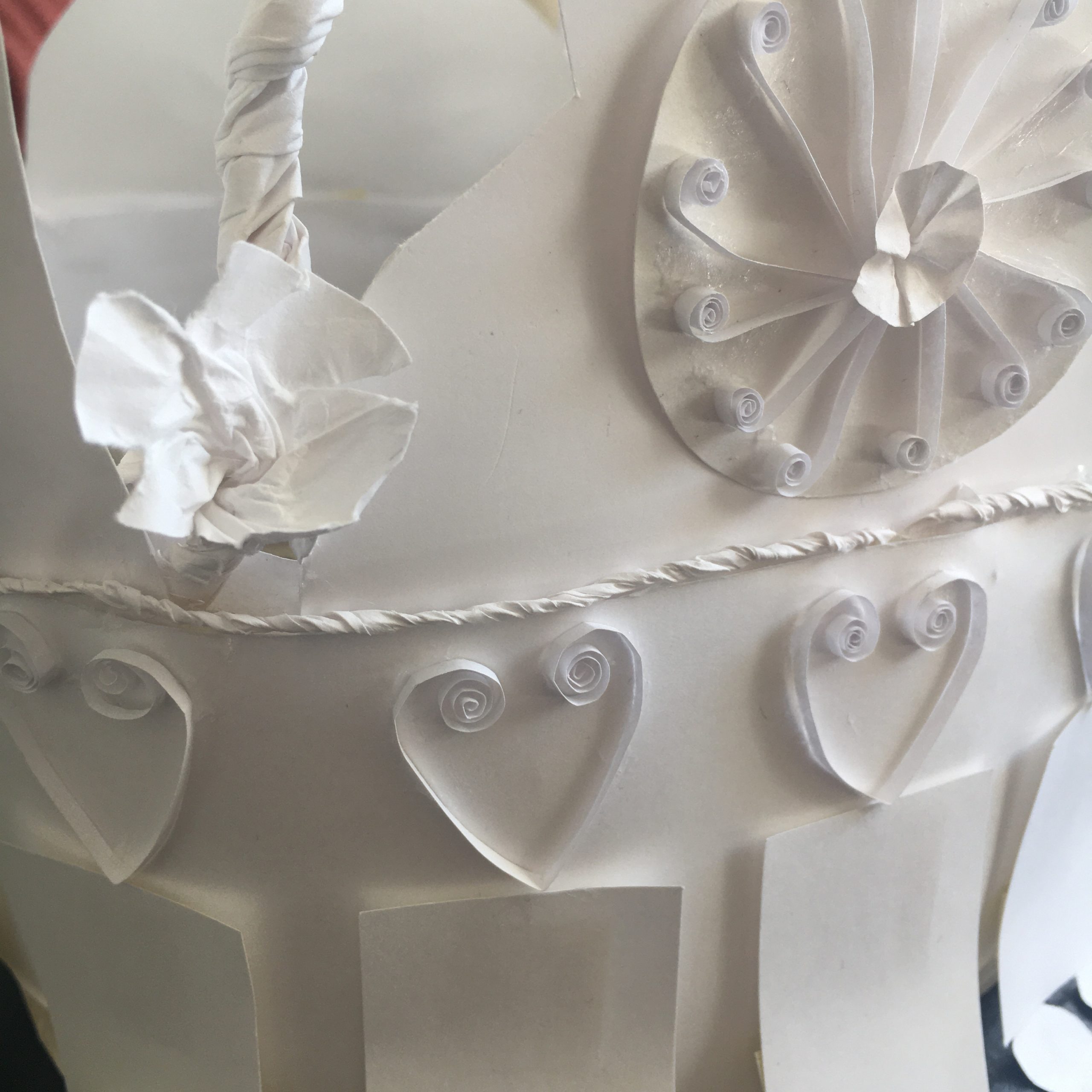The first task I was given as a student in my arts and crafts studies was to use paper to make a head creation. I immediately wanted to make an old-fashioned, traditional bridal crown from the area I grew up in. These are large crowns with beautiful, small details that were traditionally used by the bride in a peasant wedding. I chose to take inspiration from the crowns that originate from Hardanger, also the area my grandmother was born and still lives in, and where I grew up. I spent countless hours cutting, pasting, fighting against the paper to make it work the way I wanted. How the paper – the material I have worked with my whole life and which is so easily accessible and easy to obtain – should be so challenging to work with. I discovered the ways I could use paper besides just drawing and painting on it. After finishing the head piece, students had to take pictures with the head creation on, and choose an outfit that would fit. Naturally, I had my bunad (national dress) which also originates from Hardanger, sent to me so I could use it to complete the look. Even though the crown was white and light as a feather, and fragile as a wood chip, I felt so incredibly proud to be able to show my culture and my roots. Towards the end of the project we had to edit ourselves into the setting we wanted using digital editing software. I chose my background to be a meadow of apple trees in bloom in Hardanger. Finally, I edited the paper crown so that it got color and suddenly it felt almost real and natural. I had never thought that the paper would take me this far and make me feel all the emotions I did during the process and after seeing the results.

Although I worked with paper to represent one type of craft, I wanted to dig deeper into the world of traditional crafting seeing how it made me react and feel. As I mentioned to you during the meeting, I am interested in learning traditional crafts and techniques that mean a lot to others and their culture. The love and pride behind good old-fashioned craftsmanship is something that has always appealed to me. For example, last autumn I had the opportunity to weave a wool scarf and then dye the scarf with plant colors I found and made myself. Working so closely with the materials for so long, being so close to nature and using traditional methods of craftsmanship made me incredibly aware of the crafting culture. I began to discover how the scarf I had worn for so many years was woven, and how my grandmother’s woven pictures were like. I was impressed, proud and curious, but at the same time sad because this is important traditions I had overlooked and taken for granted all these years.

Well, you nailed that task! Both the crown and the photo are fabulous. It’s a cool mash-up of past and present also. It’s beautiful that you take pride in traditional cultures and I hope you get the chance to learn more crafts and make more connections and mash-ups with history.
Thank you, Maggi! I like your thought about mixing old and new traditions/cultures with new techniques. I had not thought about it like that.
Hi Katrine, I love your paper crown! It’s so beautiful, as well as the bunad! I totally understand when you said, “I spent countless hours cutting, pasting, fighting against the paper to make it work the way I wanted.” I made a paper stop-motion video before and I spent 3 entire days just cutting the papers, it was not an easy task. I’m looking forward to seeing you in person and maybe we can collaborate on a project with craft. And you’re welcome to check out my stop-motion video which I post on the home page, I’d love to know your thoughts about it.
Thank you so much, Gabby! I am also really looking forward meeting you too. You work with so many interesting tools, methods and techniques.
Paper is a surprisingly difficult material to work with. It is fun that you mention stop motion because I love working with it. All the hours of work put into a small video clip. It may look easy to make but you spend so much time on preparations, filming and editing afterwards. The feeling of mastery after completing a stop motion video is just amazing!
Hello Katrine, nice work, congratulations! This work of yours made me think of a great way to rework traditional elements to make them our own and adapt them to the context or times. I am very interested in this kind of topic, i.e. how to reuse or reinvent cultural elements belonging to the past or to certain communities without running the risk of folklorization or exaggeration. Your process of research, your photo and your proud look while wearing the clothes and the crown reinforce even more the idea you express in what you write, namely your respect and curiosity for a certain type of craftsmanship and your desire to feel it as your own, to embody it consciously.
Dear Katrine
This photograph is great, with what I call a false realism, because the viewer first becomes in doubt about the moment of photography. The viewer stops and stays in front of the picture for a long time to find the truth. Is it Photoshopped or is the subject photographed from a moment with all the components there and then? Why? It reminds me a lot of the photo artist Iiu Sisuraja’s use of props and fabric backgrounds. Susiraja does not edit her photographs.
I have worked at Sørlandets Kunstmuseum for 15 years and have seen many photo exhibitions. Your photograph, with the story that comes with it, has a good chance of being exhibited in a group exhibition for photography at an art institution. Feel free to contact the Preus Photo Museum in Moss for advice on which art institutions are most likely to be interested.